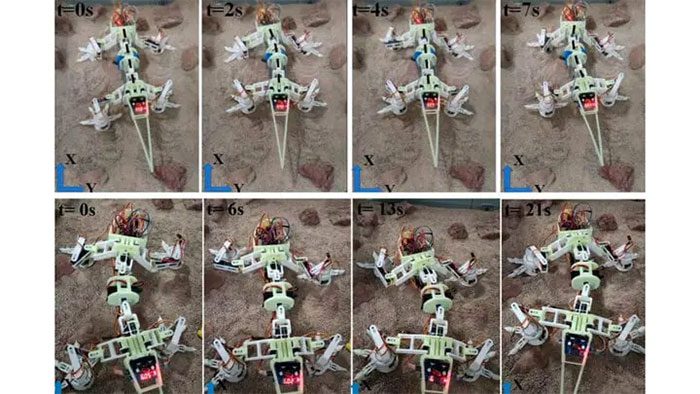Exploring Mars is beneficial for enhancing our knowledge and understanding of the potential existence of ancient microbial life there, as well as discovering new resources beyond Earth, in preparation for future human missions to Mars.
To support ambitious unmanned missions to Mars, various vehicles, spacecraft, and planetary exploration machines have been developed to conduct tasks on the Martian surface. However, due to Mars’ surface comprising different types of granular soils and rocks, modern exploration vehicles may face challenges when moving across soft soil and climbing over rocky terrain.
To address these challenges, researchers in China have recently developed a four-legged crawling robot inspired by the agile movement characteristics of desert lizards.

Initial tests have confirmed the suitability of the lizard robot for simulated Martian terrains, including granular soil and rocky surfaces. (Image: NUAA)
Developed by a team at Nanjing University of Aeronautics and Astronautics (NUAA) in China, this advanced four-legged robot is made from 3D-printed plastic and operates on a mechanism that reflects the highly flexible crawling motion with superior precision akin to that of desert lizards.
Here, the researchers designed a four-legged robot simulating the biological structure of a spine, legs, and feet similar to those of desert lizards, with upgraded joint structures to enhance the robot’s stability in movement.
In addition to the main motor, the lizard robot incorporates four additional motors to provide flexibility and stability, with eight springs to enhance load-bearing capability and reduce vibration. Each leg of the robot has two joints to facilitate climbing movements, with upgraded hip joints ensuring stable lifting. The robot’s ankles can actively rotate, and its flexible toes are equipped with claws to improve grip and adaptability to various terrain forms.
Moreover, kinematic models have been established to coordinate and create diverse movements for the robot.
Powered by a 12-volt lithium-ion battery, the lizard robot is equipped with wiring, a voltage regulator, and a controller to facilitate stable swaying motion and effective grasping of soil and rocks. According to the researchers, achieving this functionality was a challenge, requiring significant effort, time, and meticulous technical and technological calculations to bring the lizard robot project to fruition.
Initial tests have confirmed its suitability and effectiveness for simulated Martian terrains. The team claims that this biologically-inspired robot has demonstrated promising capabilities in navigating and moving over both granular soil and rocky surfaces, showcasing advancements in robotic exploration technology for extraterrestrial environments.





















































